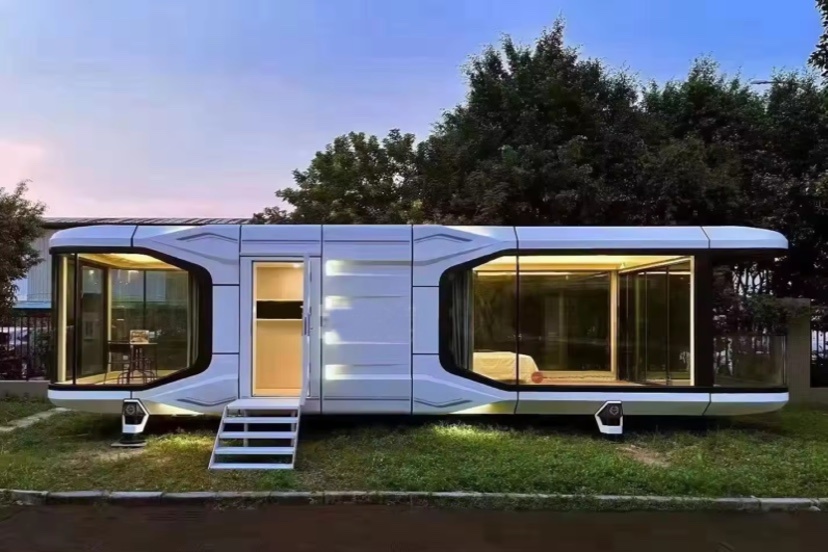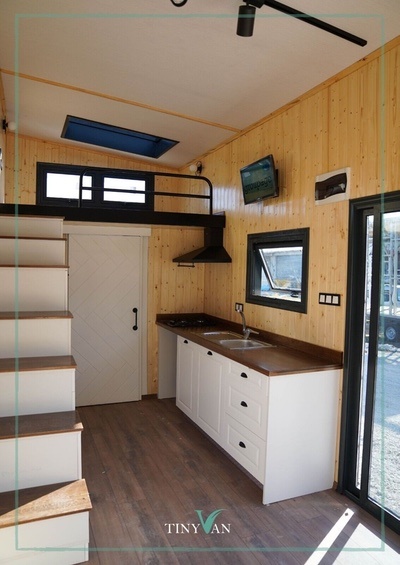Photo: Tiny home on wheels listed on eBay for $68,000.
One day in 2017, he was listening to a real estate podcast while driving for Lyft when he heard about something different: flipping mobile homes.
“I was like, ‘Wow, she’s saying it just takes $3,000 or $5,000 to start?’” [Byron] Sellers remembers. His passengers wanted him to switch to music, so he texted the podcast to his wife, Sharnice, asking her to give it a listen…
— from “Inside America’s Trailer Park Boom” by Amanda Adams on Business Insider. April 23, 2025.
In 2014, journalist Gary Rivlin was riding on a tour bus in California, visiting trailer parks, along with about 75 potential real estate investors who had paid $2,000 to attend Mobile Home University, a three-day course in the art of buying and operating mobile-home parks. Mr. Rivlin would later write an article for the New York Times, headlined, “The Cold, Hard Lessons of Mobile Home U.”
“Don’t get too hung up on appearances,” instructor Frank Rolfe reminded us as our tour bus made its way to the first of several trailer parks we would visit on a bright Saturday afternoon in Southern California. “Remember, you don’t have to live in these homes.”
This is mobile home investing, a little-known real estate sector that seems to be recession-proof and earns some of the best returns in the housing industry. Mobile homes — “manufactured housing” if you’re selling them, or “trailers” if you live in them — are the nation’s biggest source of unsubsidized low-income housing, providing shelter to about 21 million Americans.
In 2003, Warren Buffett paid $1.7 billion to buy Clayton Homes, one of the country’s largest manufacturers of mobile homes. As of 2019, Clayton’s subsidiary mortgage companies, making loans to mobile home buyers, have helped to fuel Clayton’s $13.7 billion mortgage portfolio.
In a nation where the average American household can no longer afford a single-family home, trailer parks appear to be one of the most lucrative investments around — in part because land use regulations have made it impossible — in some places — to develop new mobile home parks.
Here in Pagosa Springs, the population has tripled since I moved here with my family in 1993. In a functional community, where all types of households have access to housing they can afford, one might expect the number of mobile home parks to also have tripled. But in fact, no new parks have opened during the 30 years I’ve lived here.
From from “Inside America’s Trailer Park Boom” on Business Insider:
Between 2014 and 2024, the number of new manufactured homes shipped across the country increased by over 60%, according to census data…
…They’re cheap in part because the selling price rarely includes land; most buyers pay only for the structure. They’re also factory-built, benefiting from economies of scale. And unlike stick-built houses, mobile homes are classified as personal property, like cars, which results in lower property taxes and home insurance costs. Historically, they’ve also depreciated like cars.
Recently, Archuleta County modified its Land Use Regulations to better define, and accommodate, a style of moveable home known as the “tiny home on wheels”. THOW.
Unlike ‘manufactured homes’ — that is, mobile homes — which are typically intended to have the wheels removed and to be attached to a permanent foundation with permanent utility connections, a THOW is intended (theoretically) to remain on wheels, able to be transported from place to place, somewhat like a RV.
But then again, not at all like an RV.
The cheapest THOW I found on eBay yesterday was a used one priced at $5,000… “as low as $254.45 a month with Klarna [financing]”… located in Georgia. Several other used THOWs on eBay were priced below $40,000. New THOWs are available there for around $79,000.
But while a used THOW might seem like a reasonable option to some people, Archuleta County currently defines a habitable THOW as having an RVIA label, certifying that the tiny home was built to meet at least the safety and comfort standards of an RV. It’s my understanding that the only way to obtain an RVIA label is to purchase your THOW from a state-certified manufacturing facility. A few RVIA certified homes can be found, for example, at Tiny House Marketplace.
An alternative certification — if you are building your own THOW, for example — is NOAH (National Organization of Alternative Housing) certification, which is reportedly accredited by the ANSI National Accreditation Board and is based on RVIA certification.
Click here for a story about NOAH certification.
I’ve been writing extensively about housing issues here in the Daily Post over the past decade, while the price of housing — rented or purchased — has skyrocketed, far outstripping any wage increases in our community. I perceive the housing crisis in Pagosa Springs to be our key economic issue in need of solutions.
Our local governments have taken some baby steps in that direction. The Town of Pagosa Springs now allows ADUs (Accessory Dwelling Units) in most residential zones, and has placed limits on the conversion of homes into vacation-rentals.. The Town also allows standard 1/6-acre lots to be split into two parcels. These changes have not, however, led to a noticeable increase in affordable housing within the town limits. The biggest additions to the housing market have been two federally subsidized LIHTC (Low Income Housing Tax Credit) apartments and townhomes, and the conversion of one local motel into tiny apartments.
Efforts by the County government, meanwhile, have resulted in ten new single family homes that do not seem especially affordable, priced at $320,000 and up. But on most of the private land in the unincorporated county — even on parcels larger than 40 acres — the County regulations do not allow more than two dwelling units…
…Unless, that is, you can get rezoned as a mobile home park and meet the related land use regulations, such as water, wastewater and utility requirements.
We’re waiting to get a decision from the Board of County Commissioners on Sarah and Travis Troxtell’s proposed ‘tiny home park’ on Highway 84. Those two decisions could allow the Troxtells to move forward with their 40-unit development. The decisions were tabled earlier this month.
From the Business Insider article:
Many housing advocates have begun eyeing mobile homes as a solution to the country’s housing shortage — after some key protections are enacted, that is. Arica Young, who leads the Innovations in Manufactured Homes Network at the Lincoln Institute of Land Policy, says her organization is focused on “addressing issues in the sector, including quality, efficiency, tenant security, finance, and land use.” … More protections would most likely mean higher prices, though, and could eventually lead to investors being priced out of the market. For now, however, they’re aiming to connect buyers with what’s becoming, in the U.S., a scarce resource.
As Byron Sellers puts it, “Where else in America are you going to find a move-in-ready house for less than $30,000 to $50,000?”
Indeed. Where else in America?



